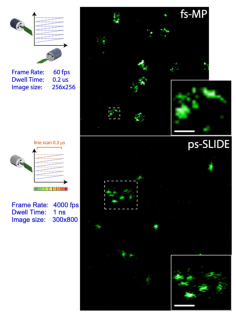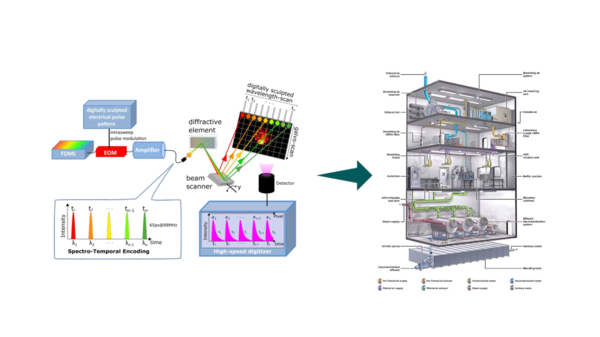Technologietransfer
Here you will find all projects and funding within the framework of a technology transfer.
FAIRCHARM
FAst InfraRed Coherent HARmonic iMaging
FAIR CHARM is an EU H2020 funded project aimed at advancing multiphoton microscopy for deeper and faster biomedical imaging (https://www.unige.ch/faircharm/). SLIDE is one of the two infrared imaging modalities developed within FAIR CHARM, promising extremely high inertia-less scan rate, high penetration depth, and fluorescence lifetime assay capability. AG Karpf is the project partner responsible for the design, development, testing, and refining of the SLIDE system. In combination with harmonic nano-particles (HNPs) developed by the consortium partner in University of Geneva, a pixel rate of 1GHz has been achieved. This allows already for two orders of magnitude of imaging rate improvement in comparison to the currently available two-photon fluorescence microscopes, based on galvo-galvo raster scanning (image).
When applied in flow cytometry, GHz SLIDE with HNPs achieves 16kHz frame-rate, enabling the scanning of entire mouse volume of blood in 200 s. Such high-throughput imaging generates extremely large datasets, inherently prohibiting meaningful manual data analysis and calling for AI-assisted data processing and analysis. Within FAIR CHARM AG Karpf is working together with partner BRC in this direction. Their software approaches enabled discarding noise and single pixel events in SLIDE data and differentiated between recognized cells and their clusters.
One of the aims within the FAIR CHARM project is to reach an unprecedented volumetric scan rate of 240 Hz. To achieve this, a functioning research-grade SLIDE microscope with a line-scan rate of 3.3 MHz has been developed, fit for fast volumetric imaging. A GPU-based data handling allows for the real time 4D volumetric imaging. Work for real tine 3D data segmentation and AI-driven analysis is ongoing.
BSLIDE3
SLIDE microscopy in a BSL3 safety class virology laboratory
Two-photon imaging enables investigations deep in tissue with low photobleaching and less photodestruction compared to confocal microscopy. Therefore, it is the method of choice in virology to study pathogens and interactions under realistic conditions. However, real-time imaging of infection processes in large volumes requires new strategies to increase the acquisition rate of two-photon microscopes. In collaboration with the Leibniz Institute of Virology in Hamburg and the Medizinisches Laserzentrum Lübeck GmbH, the novel SLIDE technology will be introduced in a biological safety level 3 laboratory as part of the BSLIDE3 project to enable imaging of virological processes at kHz frame rates. Due to the difficult environmental conditions, the system must meet high requirements in terms of robustness and reliability. Within the scope of this project, two identical SLIDE prototypes will be developed. One unit will be integrated into the LIV Hamburg halfway through the project. The second microscope will remain at the Medical Laser Centre in Lübeck to serve as a research microscope for the project. In addition, further developments of the technology are being investigated: New laser sources are being developed to realise a wider excitation range, and the use of an objective scanner enables the acquisition of volumes so that complete tissue structures can be imaged at high volume rates.













